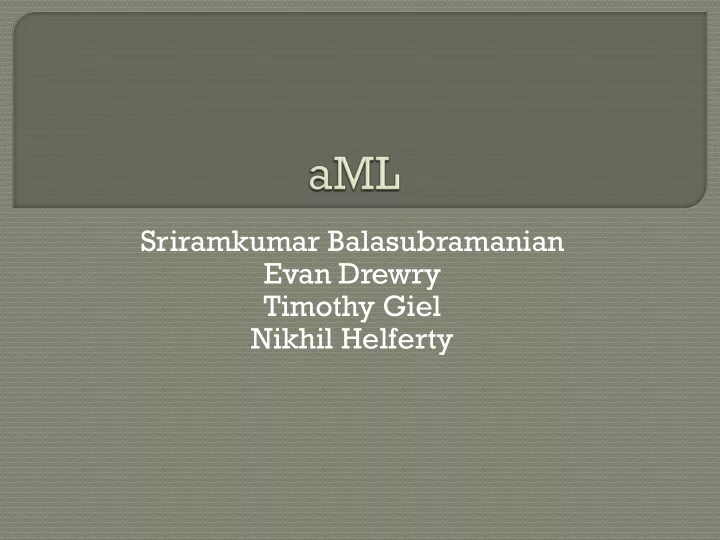

Sriramkumar Balasubramanian Evan Drewry Timothy Giel Nikhil Helferty
aML – “a -Mazing Language” Can be used to solve mazes by feeding instructions to a bot which is located at the entrance to the maze The maze can either be defined by the user in the form of text files or can be randomly generated by the standard library functions
The language serves as an instruction set to the bot, hence the movement of the bot determines accessing of various data AML is designed to not only make the process of solving mazes easier for a programmer, but also to introduce programming to the common man through mazes
A brief introduction to syntax
Java/C-like syntax (not exact) enabling you to move a bot around a maze Use functions, data types for more complex behavior than just a sequence of moves AML provides a visualization of a bot with your program navigating the maze Maze provided in .txt file or randomized
Have a limited set of available datatypes • Integer • Boolean • Cell • List<datatype> (FIFO) Functions can either return a variable type (x():Integer { }) or be void Can take parameters as well The main function must be void, parameterless
Maze text format: 5 6 • First two numbers are # rows and # columns • Then an integer follows for every 0 1 1 1 0 0 cell in row x columns maze 1 1 2 0 1 1 • 0’s are “holes” 0 0 1 1 1 0 • 1’s are “ walkable ” cells 0 1 1 0 1 3 • 2 is the start point (only one) 0 3 1 0 1 1 • 3’s are targets (multiple possible)
5 6 0 1 1 1 0 0 1 1 2 0 1 1 0 0 1 1 1 0 0 1 1 0 1 3 0 3 1 0 1 1
A very dumb bot: #load-random How to compile // function that is run by program initially • (Run “make” to main():void { construct AML) goRight(); } Run aml on .aml source • (for example, aml -c function goRight():void { example.aml) cell c := (CPos); // variables at start move_R(); // moves the bot to the Run the newly created • right java code: java example if (NOT isTarget(c)) { goRight(); }; }
#load-random main():void{ integer x := gcd(7,49); print(x); exit(); } function gcd(integer n, integer m):integer{ if(n = m){ return n; } else{ if (n > m) { return gcd(n - m, m); } else{ return gcd(m - n,n); } } }
AML will not stop your bot from looping aimlessly into oblivion • Could have prevented this possibility in previous program by, for example, limiting the number of attempts with an Integer Can design much more complex functions using Lists, recursion, bot’s “memory” Use the revert() function to backtrack
Creating the system
• Lexical Analyzer 1 • Parser 2 • Semantic Analysis 3 • Translator 4 • Top-level 5
assignment – type consistency function calls – two pass run Unique main and function definitions checking Checking for return statements inside “if’s” Functions – actual and formal parameters Validity Checking: Program -> Function -> Statement list -> Statement -> Expression
Do’s and Don’ts for the future
Start early Split up work s.t. team members aren’t blocking each others progress Keep repository updated, use incremental development style Don’t plan for “a lot” of features prematurely
Unit testing Figure out what tools exist and use them! • OCAMLRUNPARAM='p’ • ocamldep for makefiles Don’t assume anything about your teammates; figure out their strengths and split up the work accordingly
Recommend
More recommend